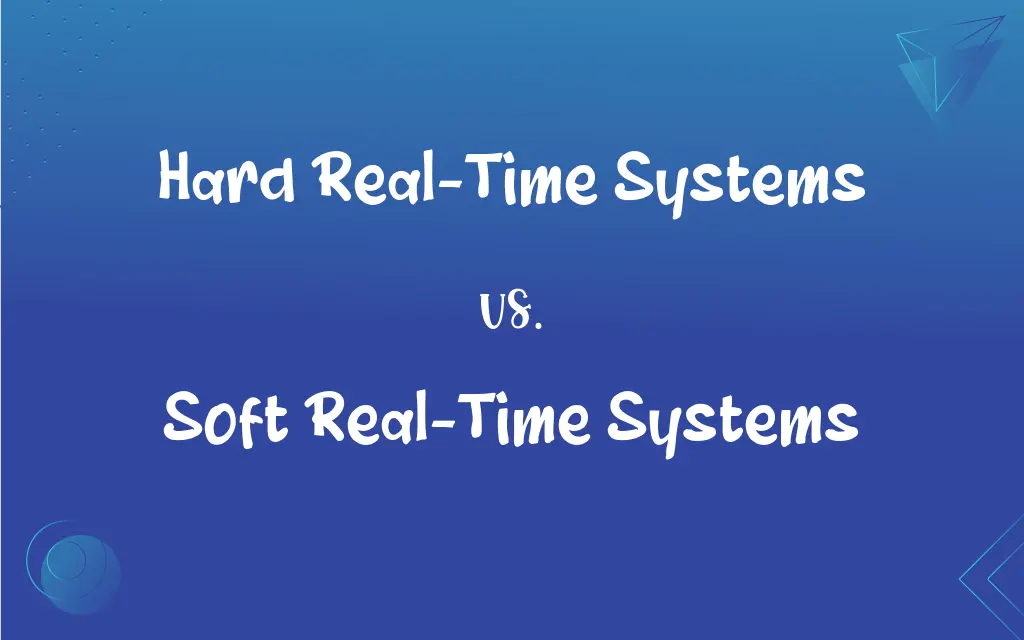Hard Real-Time Systems vs. Soft Real-Time Systems: What's the Difference?
Edited by Aimie Carlson || By Janet White || Published on February 17, 2024
Hard real-time systems guarantee task completion within strict deadlines, failure is catastrophic; soft real-time systems aim for deadline adherence, but occasional delays are tolerable.

Key Differences
Priority and Tolerance: Hard real-time systems prioritize absolute adherence to deadlines, where any delay can lead to catastrophic results. In contrast, soft real-time systems also prioritize meeting deadlines but can tolerate minor delays without severe consequences.
Hard real-time systems are used in scenarios where timing is critical, such as in medical or aviation systems, requiring rigid timing constraints. Soft real-time systems, such as streaming services, offer more flexibility, allowing for slight deviations in timing without significant impact.
In hard real-time systems, failure to meet deadlines can result in system failure or dangerous outcomes. Soft real-time systems, however, are designed to handle deadline misses with minimal impact on overall functionality.
Hard real-time systems are judged primarily on their ability to meet deadlines under all circumstances. For soft real-time systems, the focus is on average performance, with occasional deadline misses being acceptable.
Designing hard real-time systems is often more complex due to the need for guaranteed response times. Soft real-time systems may have a simpler design as they allow for some degree of flexibility in meeting time constraints.
ADVERTISEMENT
Comparison Chart
Deadline Adherence
Deadlines must be met without exception.
Deadlines are preferred but not absolute.
Consequence of Missing Deadlines
Can result in catastrophic outcomes.
Generally results in reduced performance or quality.
Typical Applications
Aviation control, medical systems, industrial automation.
Multimedia applications, data streaming.
Flexibility in Design
Minimal flexibility; requires precise engineering.
More flexibility; can adapt to resource availability.
Performance Measurement
Measured by the ability to meet strict deadlines.
Measured by average response time and overall quality.
ADVERTISEMENT
Hard Real-Time Systems and Soft Real-Time Systems Definitions
Hard Real-Time Systems
These systems are characterized by their need for precise timing and predictable behavior.
A robotic surgical system, as a hard real-time system, operates with exact timing to ensure patient safety.
Soft Real-Time Systems
They balance between timely response and system resource constraints, optimizing for overall performance.
A traffic monitoring system, as a soft real-time system, may occasionally delay data updates without major impact.
Hard Real-Time Systems
They require a deterministic response to events, ensuring actions are performed exactly when needed.
In industrial automation, a hard real-time system ensures machinery operates synchronously to avoid accidents.
Soft Real-Time Systems
Soft real-time systems are often used in applications where perfect timing is preferred but not critical.
In online gaming, a soft real-time system can handle some lag without ruining the overall gameplay experience.
Hard Real-Time Systems
Hard real-time systems are designed with redundancy and fault tolerance to avoid deadline misses.
Nuclear power plant control systems, as hard real-time systems, include redundant safety mechanisms to prevent failures.
Soft Real-Time Systems
Soft real-time systems aim for timely task completion but can tolerate occasional delays.
In a soft real-time system, a video streaming service might buffer slightly without significantly impacting the viewer's experience.
Hard Real-Time Systems
Hard real-time systems must complete tasks within strict deadlines, where failure is not an option.
In a hard real-time system, an airbag must deploy within milliseconds of a crash detection.
Soft Real-Time Systems
Soft real-time systems are typically found in consumer-oriented applications where user experience is key.
A virtual assistant, operating as a soft real-time system, may occasionally take extra seconds to respond without major inconvenience.
Hard Real-Time Systems
Hard real-time systems are often used in safety-critical applications where delays can be disastrous.
Aircraft control systems, a type of hard real-time system, must process and respond to data in real-time to maintain flight safety.
Soft Real-Time Systems
These systems prioritize deadline adherence but offer flexibility to handle unpredictable workload.
A soft real-time system like an email server may experience delays during peak hours but still delivers emails reliably.
FAQs
What are soft real-time systems?
Systems where deadlines are important but can tolerate minor delays without major impact.
What are hard real-time systems?
Systems that require absolute adherence to strict deadlines, with failure leading to severe consequences.
Can hard real-time systems tolerate any delays?
No, delays in hard real-time systems can lead to catastrophic outcomes.
What is an example of a soft real-time system?
Video streaming services are typical soft real-time systems.
What is an example of a hard real-time system?
Aircraft control systems are a common example.
How is performance measured in hard real-time systems?
By their ability to consistently meet strict deadlines.
Are soft real-time systems less important than hard ones?
Not necessarily; they serve different purposes, soft systems focus on balance and user experience.
What happens if a soft real-time system misses a deadline?
It usually leads to reduced performance or quality but not catastrophic failure.
Can soft real-time systems be upgraded to hard real-time systems?
Not easily, as they require fundamental changes in design and architecture.
Are hard real-time systems more complex to design?
Yes, due to their need for precision and reliability.
Is user experience a focus in designing soft real-time systems?
Yes, user experience is often a key consideration in their design.
Do soft real-time systems require strict timing?
They aim for timely responses but offer more flexibility.
Can hard real-time systems be used in consumer products?
Rarely, as they are typically designed for critical applications.
Do hard real-time systems have any flexibility?
Very little, as they must adhere to strict timing constraints.
Are there safety concerns with soft real-time systems?
Yes, but they are generally less critical compared to hard real-time systems.
Can both types of systems coexist in one application?
Yes, in complex systems, both types can be integrated for different functionalities.
How do soft real-time systems handle peak loads?
They may experience delays but usually manage to maintain overall system integrity.
Is cost a factor in choosing between hard and soft real-time systems?
Yes, hard real-time systems are often more expensive due to their complexity.
What industries rely heavily on hard real-time systems?
Aviation, healthcare, and industrial automation are key industries.
What role does redundancy play in hard real-time systems?
It's crucial for maintaining system reliability and avoiding deadline misses.
About Author
Written by
Janet WhiteJanet White has been an esteemed writer and blogger for Difference Wiki. Holding a Master's degree in Science and Medical Journalism from the prestigious Boston University, she has consistently demonstrated her expertise and passion for her field. When she's not immersed in her work, Janet relishes her time exercising, delving into a good book, and cherishing moments with friends and family.
Edited by
Aimie CarlsonAimie Carlson, holding a master's degree in English literature, is a fervent English language enthusiast. She lends her writing talents to Difference Wiki, a prominent website that specializes in comparisons, offering readers insightful analyses that both captivate and inform.







































































